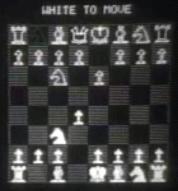
This is the first of a number of stories I have to tell about Greenblatt's chess program. Note 2 I was at work in the lab one morning, when a man I had never seen before walked in the door. He said he had heard a rumor that there was a chess playing machine on the ninth floor of Technology Square (which is where I was), and he asked if this was true. When I replied in the affirmative, he asked if he could play a game against it. I looked around, and saw that there were very few people at work. This was because it was the morning, and most of the students and researchers in the AI lab were night-owls. They usually drifted in only in the afternoon, but then they would often work through the night. Their arrival was mostly unpredictable, with the exception of Peter Samson, who lived on a schedule of 28-hour "days". Thus, each day he would come in exactly four hours later than the day before, and at the end of six of these 28-hour "days", a week had passed, and he was back where he started. Note 3
After around 30 to 40 minutes, he came over to me, and asked, "How do I resign?". I said, "There's no need; you can just leave, and I'll shut the program down." To that, he said, "But I want to resign." He indicated that he wanted me to come over to the system console, where he had been playing. The chess board was displayed on the DEC 340 display, but the system console itself was a teletype, meaning it was a printing terminal. Thus I could look back over the paper and see the commands that he had been entering. He had tried various things: "resign", "I resign", "I quit", "you win", "I give up", and so on. To all of these, the computer had simply replied with a single question mark. I told him that the program didn't have a "resign" command of any type, and all I could do was to shut it down. "But it's waiting for my next move", he said. I told him yes, and added that if we put a "Do not disturb" sign on the terminal, and went out to lunch, when we came back, it would still be waiting for his move. But I could shut it off, so someone else could use the terminal. Our visitor groped for what it was that disturbed him about my proposal. After a bit, he put his finger on it: "It doesn't know that it's won." Without thinking, I blurted out, "It doesn't care!". That upset him even more. What seemed to bother him was not that he had lost the game (which, in fact, should have bothered him, because at that point, the program wasn't very good). What bothered him was that it had beaten him but didn't give a damn. When I discussed this with others in the lab later that day, it was suggested that saying, "It doesn't care!" was not a very good idea, because it could be taken as implying that the program could have cared, but didn't. Someone suggested that a better response to "It doesn't know that it's won" would have been, "No, it doesn't even know that it's playing chess." After all, it was just an automatic machine, following pre-programmed instructions. Does your washing machine "care" if your shirts come out white? This event was hardly the first time that I had seen someone anthropomorphize a computer, and it was hardly the last. This has also been mentioned in my blog entries Chess stories and Recalculating! Even among the programmers in the lab, you'd hear anthropomorphic descriptions of what the computer was doing. For example, looking at data the chess program printed out in order to help its programmers debug and improve it, someone during the course of a game might say, "It thinks it's doing well", or "It sees the mate". But the programmers always knew they were using a shorthand. "It thinks it's doing well" meant, "The program has computed a high positive board evaluation as a result of its lookahead algorithm." "It sees the mate" was a compact way of saying, "The program has evaluated all possible responses of the opponent in the mating combination, and has determined that there is no way to avoid it." Of course, Greenblatt could have programmed the computer to accept a "resign" command, coming back with "Thank you for a challenging game." With that, our visitor might have gone away happy. Like a soft-drink vending machine I once saw which, after you inserted your change into the slot, flashed a light that said, "Thank you!". Do you think it really meant it? A few additional notes: Greenblatt's program had only a limited repertoire of error comments. If what you typed specified a particular piece, and had recognizable source and destination squares, but the move specified was not one that could be made by that particular piece, the program replied with "impossible". That happened, for instance, if the specified piece was not allowed to move to the given destination square, or if the destination square was a legal end-point, but some other piece was in the way. The program might also reply "illegal" for various reasons, such as failing to get the King out of check, or moving the King into (or through) check. But if what was typed was not even recognizable as a chess move, the computer typed the rather uninformative comment, "?". That is, it typed just a single question mark. And that had been the reply to all our new friend's attempts to resign. My own involvement with the program itself was trivial: I encoded its display of the chess board for the DEC 340 display used for the main system console (shown above). I encoded it in the display's "incremental mode" for speed; even so, it could flicker rather badly. In addition, I was an amateur radio operator at the time, and I brought my radio rig (transmitter and receiver) in to the lab. This allowed the program to play against another computer program at the ETH (the "Eidgenössische Technische Hochschule"), in English the "Swiss Federal Technical Institute", in Zürich, Switzerland (sort of the Swiss equivalent of MIT). I describe those games in entry #0037, Computer chess via ham radio.   Note 1: The program's name came from the following: "Mac" referred to "Project MAC", the project funding work in the lab. "Hack" followed, because many MIT students referred to pretty much every neat thing that they did as a "hack" (sometimes shortened to "Hac" in the program name to be analagous to "Mac"). The Roman numeral VI was in honor of the PDP-6 computer, the large DEC mainframe on which the program ran. There seemed to be different ideas about what the "MAC" in Project MAC stood for, the leading contenders being "Multiple Access Computing" and "Machine Aided Cognition". At least one wag decided that it really meant "MIT Acquires Computers". [return to text] Note 2: To see all the chess stories, go to the "footer" in this entry (just above these footnotes), and click on the keyword *CHESS. Then after reading that entry, click on *CHESS in that footer, and so on, until you've read the last entry in the *CHESS "keyword thread". [return to text] Note 3: If you get used to mentally breaking numbers down into their factors, it becomes immediately obvious that 6 28-hour days is the same number of hours as 7 24-hour days. After all, 6 × 28 = 6 × (4 × 7) = (6 × 4) × 7 = 24 × 7, Q.E.D. It's easier to factor and re-group than to actually do the multiplication (6 × 28 = 168 and 7 × 24 = 168). Samson had gotten on this schedule by just going to bed when he was tired, and getting out of bed whenever he woke up in the morning. His natural schedule turned out to be close to 28-hour "days", so he standardized it at that number. Spending most of his waking hours in the artificially lit computer lab, he had long since been ignoring whether it was dark or light outside. For the story of the most elaborate Peter Samson hack I ever got involved in, see my blog entry Amateur subway riding. [return to text]  |
 Now in 2010, a web search for chess playing programs gets millions of hits. But in the late 1960's, chess playing programs were academic rarities, not available to the general public.
Now in 2010, a web search for chess playing programs gets millions of hits. But in the late 1960's, chess playing programs were academic rarities, not available to the general public.  So, thinking that it would do no harm, I set our visitor up at the main system console of our PDP-6 mainframe computer. I gave him some brief instruction in how to enter his moves, and left him to his own devices. I chose the system console for him because it had the best display (I say modestly, having programmed it myself). The chess board looked like the one to the right, a flickering rendition of the standard image of a chess board shown in newspaper chess columns, with stylized symbols for each of the pieces. All the other time-shared terminals in the lab were text-only, showing 26 lines of 46 characters, and the chess board displays were thus much harder to interpret ("BP" = Black Pawn, "WN" = White Knight, and so on). I went off and worked at another terminal while our visitor played his game.
So, thinking that it would do no harm, I set our visitor up at the main system console of our PDP-6 mainframe computer. I gave him some brief instruction in how to enter his moves, and left him to his own devices. I chose the system console for him because it had the best display (I say modestly, having programmed it myself). The chess board looked like the one to the right, a flickering rendition of the standard image of a chess board shown in newspaper chess columns, with stylized symbols for each of the pieces. All the other time-shared terminals in the lab were text-only, showing 26 lines of 46 characters, and the chess board displays were thus much harder to interpret ("BP" = Black Pawn, "WN" = White Knight, and so on). I went off and worked at another terminal while our visitor played his game.